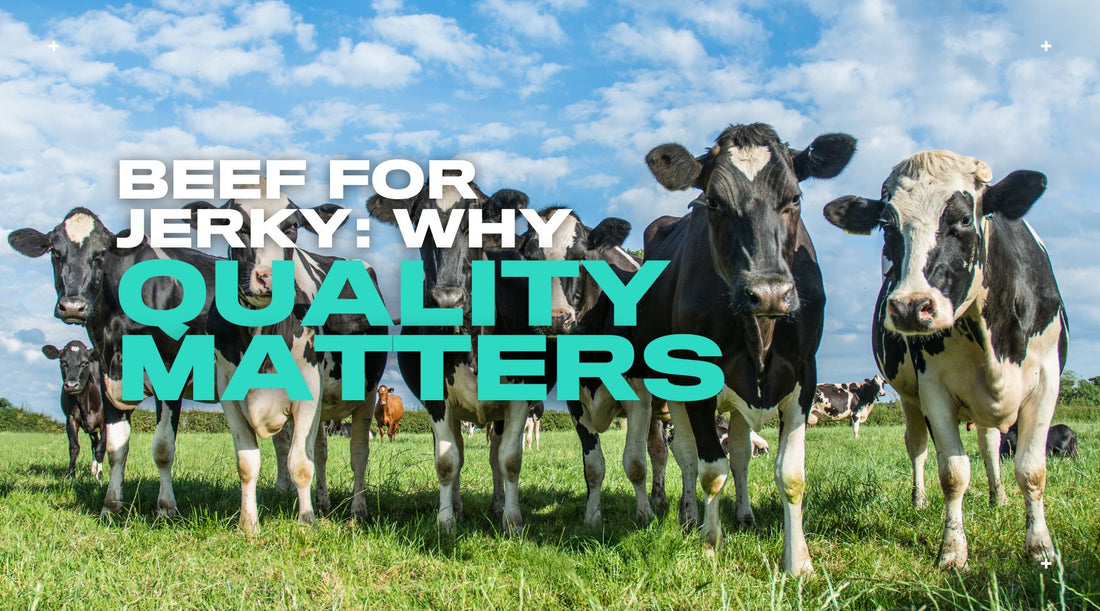
Beef for Jerky: Why Quality Matters
Beef jerky is often seen as the go-to high-protein snack—convenient, tasty, and long-lasting. But not all jerky is created equal. From the cut of meat to the way it's processed and preserved, the quality of beef you start with makes a big difference to the final product—both nutritionally and in terms of taste.
In this article, we’ll unpack what makes the best beef for jerky, explore the benefits of grass-fed beef, and reveal why Roam’s bars might just be the cleaner, more functional upgrade jerky lovers have been looking for.
What Makes the Best Beef for Jerky?
Great jerky starts with great beef. The quality of the meat determines everything—from protein content and flavour to chewiness and shelf life.
Lean Cuts are key, traditional jerky is made using lean cuts of meat like:
- Top round
- Bottom round
- Sirloin
- Flank steak
These cuts contain less fat, which helps jerky stay fresh longer and gives it that chewy texture people love.
Minimally Processed = Maximum Nutrition
The fewer steps between the cow and your snack, the better. High-quality jerky is made from whole muscle, not ground scraps, has minimal added sugar and salt & uses natural preservation methods like air drying or low-temperature dehydration

Grass-Fed vs. Grain-Fed Beef: What’s the Difference?
When it comes to beef for jerky, the animal’s diet plays a big role in nutritional quality.
Grass-Fed Beef Benefits:
✅ Higher in omega-3 fatty acids, CLA (conjugated linoleic acid), and vitamin E
✅ Fewer antibiotics and hormones used in rearing
✅ More natural, earthy flavour and richer in micronutrients
Grain-Fed Beef:
❌ Often fattier, with lower nutrient density
❌ Can include GMOs, hormones, or chemical feed
❌ Lower in key fatty acids and antioxidants
Grass-fed beef is not only better for your body—it’s better for the environment and animal welfare too.
Beef Jerky vs. Meat Bars: Which is Better?
While jerky is a staple high-protein snack, meat bars are emerging as a cleaner, more complete alternative. Here's how they compare:
|
Feature |
Jerky | ROAM grass-fed beef bar |
| Protein Content | 10-15g per serving | 20g per bar |
| Calories |
Varies (often 150–250) |
Between 105-137Kcal flavour dependant |
| Preservatives | Often includes nitrates/sugar | None - Never |
| Ingredients | Can be heavily processed or low quality |
Whole-food ingredients, grass-fed beef |
|
Portability |
Dry, shelf-stable |
Dry, shelf stable, smller |
| Flavour Profile | Savoury and chewy | Savoury, tender, natural |
The Problem with Many Store-Bought Jerkies
Unfortunately, much of the jerky on the market today is far from “clean.” You’ll often find:
-
Hidden sugars (brown sugar, glucose syrup)
-
Artificial preservatives (sodium nitrite, MSG)
-
Low-quality meat (mechanically separated or ground cuts)
- Over-processing that damages nutrient content
These additives can affect digestion, energy levels, and long-term health, especially if consumed regularly.
Roam: The Cleaner Alternative to Jerky
Roam meat bars were designed to offer all the things we love about jerky - with none of the compromises.
✅ Made with 100% grass-fed beef
✅ 20g of complete protein per bar
✅ Low Calorie
✅ No artificial preservatives or sweeteners
✅ Soft, natural flavouring and source of fibre
✅ Made with natural ingredients and nothing unnecessary
Whether you're out on a hike, post-gym, or need a clean snack between meetings - Roam delivers quality protein without the bloat, the sugar, or the sketchy ingredients.
💬 Final Thought
If you’re going to eat beef for jerky, choose quality. Start with the right cut, the right process, and ideally, the right source. Grass-fed beef not only tastes better, but it also fuels better.
But if you're looking for an upgrade on high-protein snacking, ROAM bars offer better portability, more nutrition, and none of the nonsense.
🔥 Roam. Real Fuel. Real Food.
